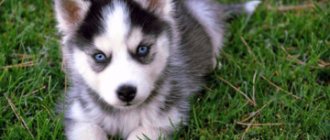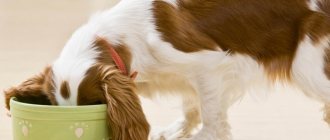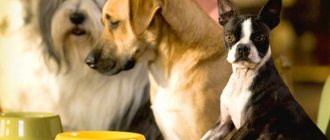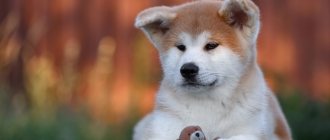What breeds of dogs are eaten in Korea? This question is asked by many European residents. In principle, the negative attitude towards eating dog meat is quite understandable. After all, for a Russian person a dog is more than a friend. In our country, these animals are the main characters of our favorite films, serve as guides and rescuers, and protect the house from uninvited guests. By the way, animal rights activists around the world also consider the actions of the Koreans to be unlawful.
However, if you look at it, all people (except vegetarians) eat meat dishes. Pork, beef, rabbit, chicken - all this also once enjoyed life, basked in the sun, and took care of its offspring. So why is the relevant question only about what breeds of dogs eat, and not, for example, what kind of chickens or geese? In this regard, the conclusion suggests itself that only vegetarians who do not eat meat at all can condemn the actions of Koreans. It is better for the rest to understand that the culture and traditions of other peoples should also be respected, no matter how acceptable it is for us.
How to feed a dog at home: basic rules
Any dog - purebred or an ordinary street mongrel - needs adequate nutrition. The body of these animals is different from the body of people, so feeding your pet everything that people eat is unacceptable. There are a number of foods that are familiar to humans, but which can cause serious problems with the functioning of the digestive organs in dogs.
Basic rules for feeding dogs:
1. Do not give food from the table. Humans eat food with various spices and other ingredients that can be especially harmful to dogs. 2. You cannot overfeed the animal. The daily ration rate is calculated taking into account the dog’s age and breed. 3. The number of feedings is 3-4 times a day for puppies and 2 times a day for adult dogs. During pregnancy, lactation and illness, the dog can be fed 3-4 times a day. 4. An animal’s daily diet must contain microelements that are beneficial for its body. 50% of the diet consists of meat and protein foods, approximately 20-30% is allocated to cereals, about 20% to dairy products and no more than 10% to vegetables and fruits. 5. It is better to feed the dog at the same time according to the schedule, for example, 1.5-2 hours before a walk or an hour after a walk. 6. Experts do not recommend feeding your dog during the day. Additional complementary feeding is only relevant during physical training. 7. After feeding your dog, you should not allow uneaten food to remain in the bowl. The container should be cleared of food residues and washed. 8. If there are several dogs living in the house, each of them should be provided with a separate bowl for food and water. 9. Pets should always have clean drinking water freely available.
Choosing food for your dog
When a dog appears in the house, it is advisable to immediately decide on the optimal type of food - natural food or ready-made industrial food.
Do not rush to make a rash choice; this issue should be approached with all responsibility, taking into account the breed of the dog and your own convenience. For example, for people who work from morning to late evening, the optimal choice is feeding with ready-made food, eliminating the need to prepare special food for the dog.
You should also keep in mind that high-quality dog food is not cheap. But you will also have to spend money on purchasing good food products necessary for a complete daily diet.
Feeding dogs with ready-made food
Ready-made industrial food is a convenient product for feeding pets that does not require preparation and calculations of the constituent components, as required by natural feeding.
There are two types of ready-made dog food - dry in granules and wet in cans with various flavoring additives. If dry food is chosen for feeding your pet, it is very important that the animal always has access to the water necessary for the absorption of granulated food.
The range of pet products includes a large selection of dog food from different manufacturers. All of them are divided into several categories: economy, premium, super-premium. Experts do not recommend buying cheap food for animals that has a low-quality or unbalanced composition, as well as all kinds of additives and flavor enhancers that are unsafe for the animal’s body. Such savings will lead to even greater costs for the treatment of a four-legged friend.
Basenji
A unique non-barking dog of the ancient African breed, the Basenji is known for its melodious voice, the sounds it makes are more like a purr. Basenjis are clean and tidy, have a keen sense of smell and a high sense of self-esteem. They love active games and communication, they are inquisitive, but not pranksters, and quickly find a common language with children.
They cannot tolerate water treatments or loneliness, and are not afraid of heights. Basenjis have a unique mind and, if trained correctly, make wonderful companions.
Recommendations for choosing dog food:
1. Consider the age and size of the dog.
All foods have labels indicating what type of animal the particular product is intended for. For example, there are special foods for puppies, for pregnant and lactating dogs, for animals after sterilization, castration, etc. 2. Carefully study the composition of the food. Perhaps some ingredients are contraindicated specifically for your animal. 3. Pay attention to the date of manufacture, expiration date and storage rules for the food. It is unacceptable to give your pet an expired product. Experienced breeders and veterinarians recommend choosing premium, super-premium or holistic food for pet dogs that has a balanced composition that is beneficial for the animal’s body.
Eating natural products
For many owners, the optimal solution is to choose natural products to feed their dog. When determining this type of nutrition, you need to immediately calculate the required daily portion for the animal, taking into account its age and breed. It is important to remember that the products served must contain all the necessary vitamins, minerals and other beneficial microelements in the correct ratio. If you have difficulty calculating your diet, consult an experienced veterinarian.
Pros of natural feeding:
1. The owner can independently choose quality products for the dog.
2. It becomes possible to completely eliminate unsafe additives, dyes, chemical elements and preservatives from the dog’s diet, which will undoubtedly benefit its body and eliminate the risks of developing various diseases. 3. If a dog is allergic to a specific food product, it can be quickly removed from the menu and replaced with an alternative product that does not cause such reactions. 4. High-quality nutrition with natural products will ensure healthy functioning of the digestive tract. Natural food for dogs involves preparing individual meals for your pet from high-quality and fresh food. It is unacceptable to cook a week ahead. Food must be fresh. Food is served to the animal exclusively warm (not hot, but not cold either).
Mixed feeding
Some owners choose to feed their dogs a mixed diet, which involves a combination of dry food with natural products.
Important:
1. It is unacceptable to give your dog natural food and food at the same time.
2. Between feeding different types of food there should be intervals of several hours. This is due to the following: it takes 3-5 hours to digest food granules, and no more than 2.5 hours to digest regular foods. In addition, different enzymes are needed to digest different types of food, and it will be difficult for the body to absorb both at the same time. With mixed feeding, it is difficult to calculate the ratio of various microelements in food and natural food, so before choosing this type of diet, think about whether you are ready for such complex calculations, because the health and lifespan of your pet will depend on the balance of nutrition.
Which variety should I choose?
The most common and common option is beef. It contains many useful elements and is not high in fat. Its use is completely safe for a dog that lives within the city. Many pets eat this kind of meat throughout their lives.
In addition to beef, dogs can be given the following varieties:
- Mutton. The daily portion should be limited, since meat is higher in calories. The optimal solution for herding and guard dogs. Lamb is very often chosen by shepherd dogs.
- Rabbit meat. Quite a dietary product that is recommended for small dogs. Not the best solution for constant use, which is associated with an increased amount of components that cause joint and kidney diseases.
- Veal. The meat is quite young, so it does not contain all the important enzymes. Excessively “empty” meat for the average pet.
- Horsemeat. A very easy option, which also should not be given daily. Many dogs do not like meat and frequent consumption of it can cause an allergic reaction.
- Venison. The most preferred option in the Far North, which is used instead of beef. The product contains a balanced set of elements.
- Bird. Turkey and chicken meat are often purchased as part of a diet or to save money. It is important to remove fat and skin, and remember that this is not the best option for dogs. The first reason is the use of hormones when raising poultry. The second is that chicken often contains parasite larvae.
- Giblets or offal. An ideal solution for variety, but cannot replace full-fledged meat. Often, pet owners choose unprocessed beef tripe.
Remember that feeding pork to dogs is not recommended. This is an excessively fatty product that contains almost no useful elements. The animal's stomach is not able to fully digest this meat, so you are simply throwing money away. In addition, the dog's health will suffer.
BARF dog feeding system
In recent years, the BARF animal feeding system has become increasingly popular among dog breeders. This type of nutrition is based on natural food, close to wild nature.
The basis of the BARF diet:
• meat bones;
• raw meat of different varieties; • offal; • fish, including raw fish; • raw vegetables in any quantity; • greenery; • raw eggs; • dairy products; • fruits and berries; • olive and linseed oil; • fish oil or cod liver oil. According to the founder of the BARF animal feeding system, dogs are predators, so the basis of their diet should be the natural diet of their wild ancestors. Such food is useful and healthy for animals. As for raw foods, according to the author of this feeding method, food after heat treatment loses a number of nutrients necessary for the body, and therefore is useless for the animal.
You need to gradually accustom your dog to eating according to the BARF system, following some recommendations from the creator of the method. In order for the body to get used to such food, at first, 30 minutes before meals, you need to give the dog a prebiotic and bifidobacteria, which normalize the intestinal microflora. Each new product is introduced gradually, in small quantities. As soon as the dog completely switches to the new diet, you can eliminate the medicinal components, since they will no longer be needed by a healthy body.
Sapsali
- Height: from 48 to 58 cm
- Weight: from 16 to 28 kg
- Life expectancy: 14 to 16 years
Peregrine Sapsali is one of the few breeds that has long occupied a special place in Korean folklore. As legend has it, these dogs can scare away evil spirits and ghosts thanks to their supernatural abilities. Although such legends are difficult to believe, one cannot deny the delightful appearance of the peregrine, which has helped the breed gain popularity outside its homeland.
Interesting fact: according to Korean law, peregrine falcons are a national treasure. Koreans believe that peregrine falcons preserve families and bring good luck.
Many experts believe that this breed originated in the first century AD and is one of the oldest dogs in the world. During the World War and the Korean War, the breed was close to extinction, but thanks to the efforts of the government and some breeders, the peregrine still exists.
This breed of dog was a companion to royal families in ancient times, the peregrines received their high status due to their lion-like faces, docile temperament and long shaggy coat. Today they are excellent companion dogs and show dogs.
Peregrines are very similar to bobtails. They are alert, perky and energetic. This dog breed is famous for its playfulness, intelligence and easy trainability. They are always ready to play and are very loyal to their owner. They require constant mental stimulation.
Sapsals are healthy dogs. They have excellent immunity to most canine diseases. They are prone to health problems such as food allergies and hip dysplasia.
RAW power system
Another popular method of feeding domestic dogs is RAW, which is also based on natural raw food. Unlike the BARF system, this method involves feeding the animal meat not in a cut state, but in the form of a carcass or half-carcass. The meat should have bone and blood. There is a taboo on foods that have undergone heat treatment, as well as on chopped bones.
The RAW diet includes offal and sea fish, preferably whole and fresh. But dairy products, eggs, vegetables and fruits are completely excluded from the daily menu of a dog eating according to the RAW system.
By the way, RAW and BARF nutrition is inappropriate for feeding dogs of decorative breeds, since their body is not adapted to assimilate food familiar to predators in the wild.
Bedlington Terrier
Graceful, flexible and muscular terriers are followers of an active lifestyle. They love long walks, playing with a ball, and are excellent swimmers. Passionate and brave fighters with the appearance of a sheep. Due to the contradiction in character and appearance, Bedlingtons are often called “the lamb with the heart of a lion.”
The past of Bedlington Terriers is quite confusing: they were used to catch rats in mines, for burrow hunting of badgers and foxes, they participated in dog fights, performed tricks in gypsy shows, and lived in the palace of the Queen of England.
Representatives of this breed are clean, intelligent and aristocratic, and do not tolerate rude treatment. They adore children and love their owner with all their hearts.
What you can and cannot feed your dog: list of products
Since most dog breeders choose a natural type of diet for feeding, let’s consider what foods should be included in a pet’s daily menu and what should not be given to animals, even sometimes.
Healthy foods for dogs:
• meat, poultry;
• offal; • chicken and quail eggs; • cereal porridge (rice, buckwheat, oatmeal, barley); • fresh vegetables; • greenery; • unsweetened berries and fruits as a tasty treat; • fermented milk products with a small percentage of fat content; • pumpkin, olive, flax oil; • bran; • raw bones (except tubular ones); • sea fish (no more than 1-2 times a week). What you should not feed dogs: • bakery products; • sweet pastries; • pasta; • it is undesirable to feed fatty meat; • pickles and preserves are prohibited; • mushrooms; • fried foods; • corn and semolina (poorly digestible); • soy products; • grapes; • garlic, onions; • spices should not be given. To keep your dog healthy, physically strong, and live for many years in your home, create for it a healthy and balanced diet of high-quality, fresh food. If you choose ready-made industrial feeds for feeding, give preference to products of proper quality. Remember: your pet's health is in your hands!
Why did I do this
Country is people. And although we are all one, at the same time there is an abyss between us.
Traveling cannot be limited to just visiting attractions and going to expensive restaurants. You can't see the country from your hotel window. Although I don’t argue that a certain amount of comfort is important for maintaining mental health. Otherwise, you can go crazy after drinking ayahuasca with shamans in the deep jungle.
Listening to music, eating local food, joining the everyday life of ordinary people, you seem to penetrate into the subcortex of culture. You get a chance to feel what other people feel. This is an experiential journey in which your own body acts as a guinea pig.
At the same time, I'm studying myself. I am also a human being, and between my consciousness and me there is also an abyss. What I can? Where are my boundaries?
I encountered my boundaries at a Korean restaurant in Bishkek. No more dogs.
Read also: Kyrgyz cuisine. What do nomads of Central Asia eat?
Jeju
- Height: from 48 to 54 cm
- Weight: from 18 to 25 kg
- Life expectancy: 13 to 15 years
Jeju were originally bred on the island of the same name, located off the coast of Korea. They are very similar to the Korean Jindo, but with more pointed foreheads. It would be hard to find a rarer dog than the Jeju, as the breed was virtually wiped out in the 1980s. The three surviving specimens were used to revive this ancient breed, which originated on Jeju Island more than 3,000 years ago . In 2010, there were only 69 purebred Jeju in the world, although their numbers are now growing thanks to an aggressive conservation campaign.
Fun fact: Breeders say that a purebred female Jeju should look like a fox, and a male should look like a wolf.
This is one of the largest native dogs of Korea. Jeju owners claim that their pets are highly territorial , hardy, alert and brave, making them ideal watchdogs. They are wary of strangers. Be sure to train and socialize them at a young age to prevent the development of aggressive behavior.
The Jeju have an average lifespan of 14 years, and they remain active throughout their lives. This breed is prone to mange, food and skin allergies.











